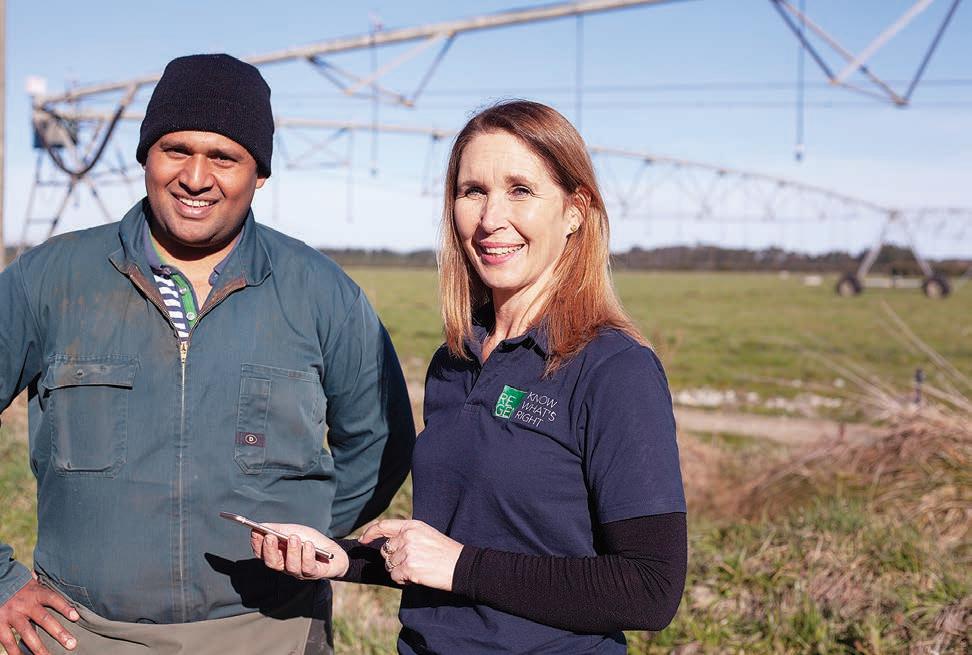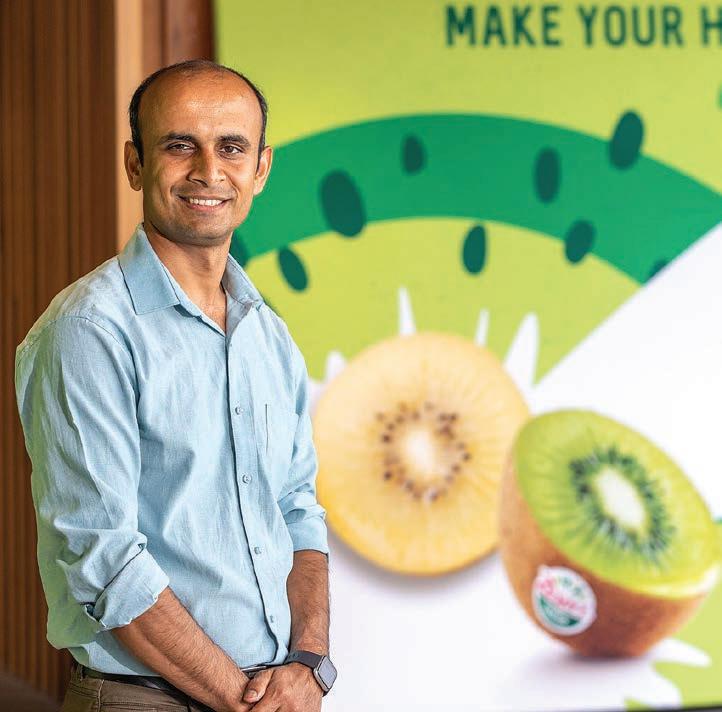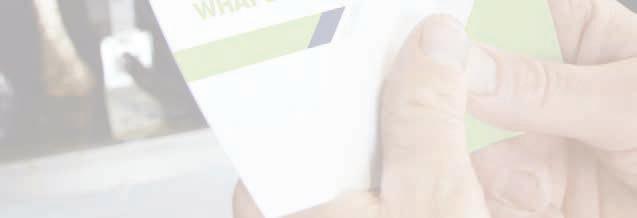
13 minute read
Technology
from Dairy Farmer December 2020
by AgriHQ
or how it can affect their operation by increasing efficiencies and, in turn, boost their bottom line.
New Zealand company Regen, established 10 years ago, uses a network of on-farm sensors that feed soil and climate data into the cloud to help manage 18,000ha, giving farmers advice on when to irrigate, but chief executive Bridgit Hawkins says most clients don’t realise IoT is at the heart of the platform.
“Although IoT is incredibly important for us and our customers, they still don’t actually know what it means, so it’s really important we don’t talk about having an IoT solution, because they’re not 100% don’t need one of those.”
But IoT is actually already part of many Sensors feed soil and climate data into the cloud to help manage 18,000 hectares, giving farmers advice on when to irrigate. They can
Data is the new oil
By Tony Benny
In the fast moving world of technology, changes and advancement are continually happening in the agritech space, which is helping farmers in ways their ancestors couldn’t have imagined.
The Internet of Things (IoT) is facilitating enormous change in agriculture, even though most farmers barely know what it is
sure what it is,” she says. Regen chief executive Bridgit Hawkins, with farm worker Rahui Save, says the
“As a result, they’re pretty certain they Internet of Things is a big part of farmers’ businesses.
even be used in greenhouses for plants. farmers’ businesses, Hawkins says. the farm, as well as using two external 2000 data points every single day
One of Regen’s customers, a sources, to inform decisions about that is brought together through IoT Canterbury-based dairy farm, has 18 irrigation. connectivity, our platform and the separate sensors, or data sources, on “So for that single farm, that’s over algorithms that underpin it to give to

them what appears to be something really simple, enabling them to actually use that data,” she says.
Add to that the data collected in dairy sheds covering animal health, milk quality and milk temperature, and from farm machinery recording activities like fertiliser application, that’s an enormous amount of information being uploaded to the cloud. Companies like Regen, recently acquired by Israeli-based soil sensing and data analytics company CropX, specialise in unscrambling that data and turning it into something useful for farmers.
“If a guy’s got cows to milk, breaks to move, fertiliser to apply and staff to manage, wading through tens of thousands of data points himself to work out what to do and how these different activities interlink, is not something they’re ever going to do so for us in the industry; being able to actually pull these things together and create the insights that are meaningful is what’s required to enable the power of the technology,” she says.
Hawkins was among the speakers at a recent online webinar hosted by AgritechNZ together with Amazon Web Services, the leading provider of technology and software to companies working in the IoT world.
“The world is changing, this is true not only for agriculture, but for any industry as we spend more time at home nowadays with technology, and leverage ways to get things done more efficiently with technology,” AWS head of IoT for agriculture Rachel Bradshaw says.
She says farming has changed more in the past 120 years than in the previous 10,000 years, and that’s being accelerated by IoT.
“If you took a farmer from 425BC and that farmer visited a farm in the 1900s, he would still see tools he recognised and have the capability and the skillset to use those tools, but if you took that same farmer and put him on a farm of today, he would probably think he’d landed on a completely different planet and that’s because there have been so many changes,” she says.
The changes over the past century or so include the introduction of selective breeding of livestock, the use of fertiliser, mechanisation and the use of irrigation. Alone, those changes have transformed agriculture but even bigger change is imminent, says Bradshaw.
“You’ve probably heard the saying, or you soon will, that data is the new oil, which means that it is so valuable Amazon Web Services head of IoT for agriculture Rachel Bradshaw says the collection of data and using it to create efficiencies and profits is already happening with 75 million online devices in use.

to companies because it helps them understand their business better, what customers are interested in, and what they like and don’t like,” she says.
“It helps farmers understand how to better produce their crops, how to improve soil and how to have happier livestock which, in turn, increases yields.
“There’s all this information that can come from data and we’re seeing deeper focus on data.”
Bradshaw says with the world needing to produce 70% more food by 2050 to feed an expanding population in the
Folium monitors temperature, humidity, CO2, barometric pressure and radiation in greenhouses, down to individual plant level. “It helps farmers understand how to better produce their crops, how to improve soil and how to have happier livestock which in turn increases yields.” Rachel Bradshaw

face of challenges, including diminishing arable land, climate change, a depletion of natural resources and a declining workforce, innovative technology has become imperative.
Already IoT is being harnessed by companies like New Zealand-based Halter to monitor cow health and enable stock to be herded remotely; Teralytic, who make probes to monitor soil moisture and nutrient levels, and Autogrow Systems, which recently introduced a new product called Folium for use in greenhouses.
“When I first got into IoT the common question was, ‘Can we do it, is it technically possible?’ But, over the past seven or eight years this has become significantly easier,” says Autogrow chief technology officer Jonathan Morgan.
Folium monitors temperature, humidity, CO2, barometric pressure and radiation in greenhouses, down to individual plant level.
“I was talking to one of our consultants the other day, and he said 20 years ago a microclimate was your farm and then we started getting more into a controlled environment and a microclimate became your greenhouse and now microclimate is your plant,” Morgan says.
Bradshaw says the collection of data and using it to create efficiencies and profits is already happening and the trend is bound to accelerate. She says there are already 75 million online devices in people’s hands around the world, and that is predicted to rise to 225m by 2025, “or even jump into the billions.”
“For us that means having a fullyintegrated, collaborative system,” she says.
“It means you’re able to meet the changing demands and conditions within your operation, within your supply network, and meet your customer needs.
“This allows you to have control of your data to enable your business and employees to make data-driven decisions.” n
Challenge ends as real work begins
Dr Chandra Ghimire from AgResearch at Lincoln won the New Zealand Research Stream sponsored by Zespri. Pulling water from thin air and artificial intelligence could be two answers to support water sustainability. Water is essential to all facets of agriculture and food production and we need innovation and collaboration to ensure quality and availability into the future.
The Water Challenge was launched in February by Australian-based
Bridge Hub, which is an agrifood tech innovation hub, and has attracted over 150 researchers and entrepreneurs from
Australia, New Zealand and Israel. The 2020 winners were recently announced.
“Our aim was to uncover the best and brightest research, the most innovative ideas, and the best start-ups that positively impact water quality and availability across our agrisystem,” Bridge
Hub co-chief executive Craig Shapiro says.
“Winning solutions as diverse as creating water from air, measuring water with acoustics and sludge-free waste recycling for remote communities, highlights that the Water Challenge has been successful in its aim of uncovering some of the leading cutting-edge solutions currently being developed.”
The winning teams receive recognition and prize money but more importantly, connections and the ability to collaborate across the globe with other like-minded communities who share Bridge Hub’s passion for solving global water-related problems are developed.
He says the quality of not only the winning solutions but of all the applicants highlights that we have the capacity to achieve anything if we turn our minds to the task at hand. Adding our ability to solve problems across the entire agrifood supply chain is only limited by our imagination, as long as we have the right frameworks in place.
In announcing the winners, he says, “While today marks the end of the Water Challenge, it is just the beginning of a bigger journey of working with a global community of like-minded organisations and individuals to transform many of the big ideas and solutions submitted into impactful and successful outcomes.”
The Water Challenge wraps up at a time when agrifood research bodies are increasing their focus on both commercialisation and adoption of

The winning technology from Dr Chandra Ghimire works by bouncing soundwaves off the paddock surface to detect surface water.

research, climate change continues to present global challenges and Australian agriculture considers how it achieves its goal of becoming a $100 billion industry.
Significant funding is being allocated by many governments to help underpin the future growth of the agriculture and food sectors with many positive initiatives underway. Many of these include a focus on drought resilience and water quality.
Shapiro believes there will be an increasing pool of capital available to be allocated to investment opportunities in the agrifood tech sector. Including capital from a growing pool of global impact investors, who require normal financial returns but also want their investments to have a positive and sustainable impact on the environment or society.
“Ultimately, we need the private sector, research and government working together to increase investment which will underwrite the successful and sustainable future for agriculture and food production,” he says.
“The establishment of industry-led agrifood tech bodies such as AgritechNZ and Ausagritech, will also help to drive investment towards the rapidly growing agrifood tech sector.
“We are extremely optimistic about the direction we’re heading and particularly how the ideas unlocked from the Bridge Hub 2020 Water Challenge can play a role in that sustainable future.”
Bridge Hub 2020 Water Challenge winners
• Australian Research Stream sponsored by CSIRO
Advanced Capture of Water from the Atmosphere (ACWA) – Professor
Chiara Neto, The University of Sydney for groundbreaking research that is working on a new water solution that aims to capture water from the air. • New Zealand Research Stream sponsored by Zespri
Real-time control of irrigation through acoustic sensing to prevent runoff and pollution. (Acoustic sensing for
Irrigation) – Dr Chandra Ghimire,
AgResearch Ltd. Lincoln New Zealand for research that is using acoustic technology to help irrigators to be smarter with their water efficiency.
Australian Startup Stream sponsored by Commonwealth Bank Streamwise DI – Paul Hatten, of Clayton, Victoria, for a waste water solution that improves environmental outcomes and operating efficiencies of food manufacturers through the use of artificial intelligence. New Zealand Startup Stream Sponsored by Wharf42 RiverWatch – James Muir, Matarangi, for a water quality solution that provides real time monitoring and decision-making for our rivers and waterways. Israel Startup Stream LagunaTech –Clive Lipchin, Arava Institute for Environmental Studies, Kibbutz Ktura, for decentralised wastewater treatment solution that assists remote and off-grid communities to create new water sources. n
MORE: For more information about the Challenge,


visit waterchallenge.co


‘Third eye’ to save time and money
By Tony Benny
Agriculture technology is being developed at pace, and now Big Brother can identify lameness in herds and send a message directly to a cellphone.
New technology will allow dairy farmers to keep an eye out for lame cows simply by looking at their smartphone, thanks to a camera mounted at the entrance or exit of their shed that feeds the pictures to the cloud and uses artificial intelligence (AI) algorithms to analyse the animals’ gait.
UK startup CattleEye has developed the system using computer vision, a rapidly growing technological area increasingly being harnessed to identify, count and sort anything, including farm animals and horticultural produce.
Amazon Web Services (AWS) worldwide head of solutions architecture for the agriculture industry Karen
Hildebrand told attendees at a recent webinar hosted by Agritech New Zealand that computer vision takes the collection of data to another level.
“Agriculture is a data-rich industry, A new device developed by a UK startup will help farmers identify any lameness in but we all know that vision really makes their herd. a difference in understanding what you would do differently. What we talk about is how do we scale vision, how do we see have lameness, but they’re also able to When you lift the bonnet on these things that the human eye could see but share that all the way through to the end technologies there is a lot going on but we can’t necessarily scale to a number of consumer who wants to be able to feel when it comes down to it, the concepts humans to be in all locations where we the animals were raised in a happy and are relatively simple,” Merten says. want to see something,” Hildebrand says. healthy way.” Computer vision, along with the
“We ask, ‘what could you do if you AWS provides the technology and IoT and robotics, is at the heart of a could scale your eyesight? What are support for developers with a range of revolutionary way of beekeeping, called the problems that you could solve if “out of the box solutions” for industry. BeeWise. Instead of traditional beehives, the constraint of being able to actually And for more complex applications, up to 40 colonies can be housed in one physically go there and see with your Wellington-based Amazon principal structure where climate and humidity, own eyes is no longer a blocker?’” solutions architect Steffen Merten pest control, swarm prevention and
CattleEye is just one of hundreds of demonstrated how easily a programme even harvesting are done automatically, applications being developed, both in could be taught to recognise and count with all the information fed back to a agriculture and other industries. kiwifruit, as well as identifying different smartphone.
“They can look from above as the cow varieties. “We are not changing how beekeeping moves down an alleyway and detect “Computer vision is one of those is done, we are simply applying it in what the lameness score would be for things like artificial intelligence, machine real-time, with a robotic arm vs a human early interventions,” she says. learning, big data and the Internet of one,” BeeWise’s website states.
“By doing that they can keep the dairy Things (IoT), where it can seem pretty “It’s as if every bee had her own herd more productive because they don’t complicated and difficult to understand. beekeeper 24/7, rain or shine.” n










